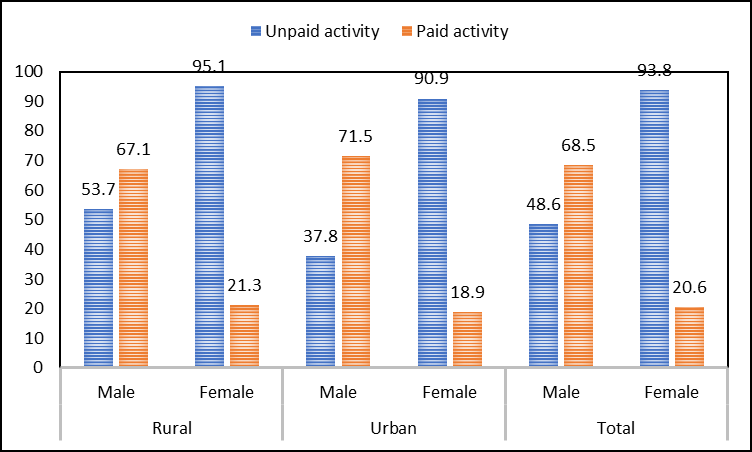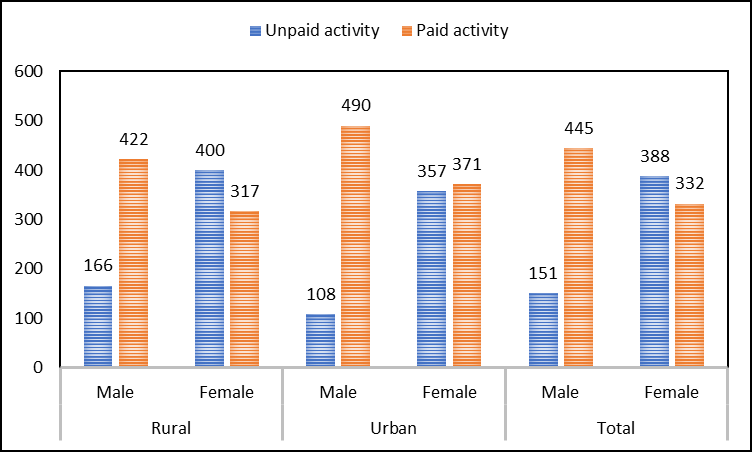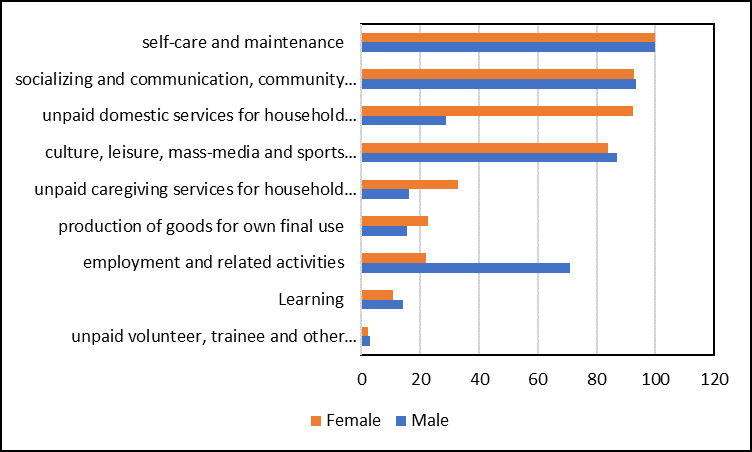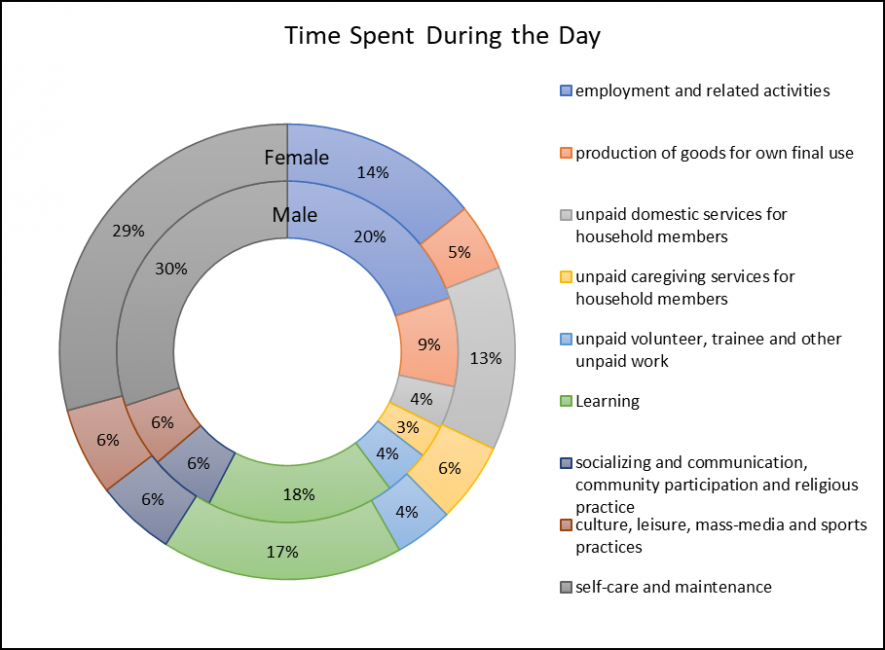Are Women Really Working Less in India?
Image Source: The Financial Express
The “Time Use Survey” (TUS) is the first survey of its kind launched by the National Statistical Office (NSO) to provide information about the activities performed by every individual and the time spent in all of these activities during January-December 2019.
The survey covered 4.5 lakh persons of age 6 years and above across 1.4 lakh households in India and the respondents were asked to recall their activities performed during the last 24 hours of the day of the survey.
There is no doubt that there are some critical concerns regarding the methodology of the survey but it has been claimed as the best available method in a country like India with a low literacy level.
However, the much-awaited TUS (2019) also has its limitations as it does not consider the International Labour Organisations’ resolution on Statistics of work, employment and labour underutilisation and so it cannot provide information on the employment status of persons.
Moreover, the TUS records data for one or two days per person in a week and there is a high chance that a significant proportion of the population will simply be outside its coverage, given the widespread presence of the informal sector in India, where work pattern is irregular and erratic.
Another objective of the TUS data was to implement and achieve Sustainable Development Goals (particularly SDG 5.4 on unpaid work) but the Indian TUS data are inadequate in envisioning this because unpaid work is estimated using the labour input method only and leaves out the capital and technology used.
Despite these shortcomings, the TUS is unique in comparison to other household surveys, as it offers a framework for measuring time dispositions on different aspects of human activities like paid activities, unpaid activities, caregiving activities, volunteer work, learning, socialising, leisure activities and self-care activities, which are otherwise not possible in other surveys.
According to the latest TUS data (2019), the workforce participation rate of women of the age group 15-59 years is significantly lower compared with men. Also, urban women participated less in the workforce relative to rural women in India.
Figure 1 shows that only 21% women are working in contrast to 69% men, but almost all women (94%) are involved in unpaid caregiving and domestic activities in India during 2019. While only around half of the men are engaged in unpaid activities and the bigger gender gap in the unpaid workforce participation rate is also reflected in spending less time in such activities by men compared with women in India during 2019.
On average, women spend daily six and a half hours on these unpaid activities whereas men spend daily two and a half hours only in 2019 (Figure 2). Furthermore, in rural areas, women spend larger time in unpaid activities compared with women in urban areas, but the difference between women’s and men’s unpaid work time is higher in urban areas.
Figure 1: Percentage of persons participating in a day in paid and unpaid activities

Note: Age Group 15-59 years, Source: Calculated from Time Use Data (2019)
Figure 2: Time spent in a day in paid and unpaid activites (minutes per day)

Note: Age Group 15-59 years, Source: Calculated from Time Use Data (2019)
In the TUS (2019), the activities reported by the respondents are classified following the International Classification of Activities for Time Use Statistics, 2016 and it provides a detailed break-up of paid and unpaid activities. It also divides “residual activities” into a wide range of activities like learning, socialising and communication, community participation and religious practice, culture leisure, mass-media, sports practices and self-care and maintenance.
Figure 3 depicts that more men participate in employment and related activities daily compared with women, whereas the proportion of women involved in unpaid domestic services and unpaid caregiving services for household members are larger in India during 2019.
Similarly, more women (22%) are also involved in the production of goods for own final use which is also a unpaid activity as it includes different activities like growing crops and kitchen gardening, farming of animals and production of animal products for own use and supplying water and fuel for own final use, compared with only 15%men in 2019.
Furthermore, between rural and urban areas, more rural women (28%) are engaged in the production of goods for own final use compared with 9% urban women because of the larger presence of agricultural-related activities and less availability of affordable fuel and clean drinking water within the household premises in rural areas.
It is disheartening to note that 12% of women in rural areas and 6%of women in urban areas need to fetch water far away from natural and other sources for their daily household purposes in India during 2019.
On average, women spend more than one hour daily in collecting firewood, other natural products for use as fuel to reduce out-of-pocket expenditure in rural as well as urban areas in 2019. Similarly, women spend an average of 55 minutes a day to fetch water for household daily use purposes during 2019.
A further break-up of unpaid household chores indicates that 87%of women are involved in preparing food for all members of the household, 72% manage cleaning and mopping of the house on their own and 48% are washing, drying and ironing clothes of all the household members alone and spend more than six hours daily in all of these.
However, within care work, women spend larger time (141 minutes) daily in caring for children, including feeding, cleaning, physical care, teaching, training and minding (passive care), whereas men spend higher time in taking care of dependent adults, assisting them with tasks of daily living, providing them medical and passive care.
Figure 3: Percentage of persons participating in different activities in a day

Note: Age Group 15-59 years, Source: Calculated from Time Use Data (2019)
Figure 4: Average time spent in a day per participant in different activities

Moreover, 94% of rural and 89% of urban women are involved in daily domestic duties of cleaning and cooking and they spend more than five hours daily providing these basic facilities to other household members. However, women in urban areas can outsource some of these responsibilities by hiring domestic help but women from the poorest consumption class have to bear the burden on their own.
Similarly, one-third of women in India shoulder the responsibility of providing care to other household members daily and spend more than two hours daily on this. It is interesting to note that within unpaid work, women spend 17% of their time in unpaid household chores and caregiving activities whereas men spend 7% of their time (Figure 4).
On the other side, men get more time for self-care and maintenance whereas because of their larger responsibility of unpaid care, women get less time for the same.
Certainly, if an attempt is made to include the entire realm of ‘unpaid work’ into the formal definition of work, then more women (95%) than men (85%) usually work in India.
In a nutshell, the main finding of the TUS of larger involvement of women in unpaid domestic work and care services and less towards paid employment, is nothing new in India. Since the 1980s, feminist economists have vociferously argued for measuring a large volume of the work that women do which remains unrecognised and therefore, unpaid but indicates about the time poverty faced by women which have a direct impact on their quality of life.
It also undermines the quality of goods and services provided through unpaid services and fails to recognise the importance of the services provided by the caregivers in our society.
It is, therefore, extremely important to recognise the same and make people understand the value of such services for the proper functioning of the social system.
Dr Shiney Chakraborty is affiliated with Institute of Social Studies Trust, New Delhi. Views are personal.
Get the latest reports & analysis with people's perspective on Protests, movements & deep analytical videos, discussions of the current affairs in your Telegram app. Subscribe to NewsClick's Telegram channel & get Real-Time updates on stories, as they get published on our website.
























